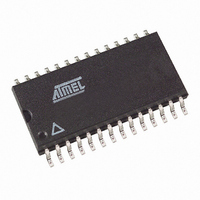TDA4470-MFLG3Y Atmel, TDA4470-MFLG3Y Datasheet - Page 3

TDA4470-MFLG3Y
Manufacturer Part Number
TDA4470-MFLG3Y
Description
IC SOUND PROC VIDEO-IF 28SOIC
Manufacturer
Atmel
Type
Videor
Datasheet
1.TDA4470-MFLG3Y.pdf
(24 pages)
Specifications of TDA4470-MFLG3Y
Applications
VIF/SIF Signal Processing
Mounting Type
Surface Mount
Package / Case
28-SOIC (7.5mm Width)
Lead Free Status / RoHS Status
Lead free / RoHS Compliant
2. Circuit Description
2.1
2.2
2.3
4803C–TVVCR–10/05
Vision IF Amplifier
Tuner-and VIF-AGC
FPLL, VCO and AFC
The video IF signal (VIF) is fed through a SAW filter to the differential input (pins 6-7) of the VIF
amplifier. This amplifier consists of three AC-coupled amplifier stages. Each differential amplifier
is gain controlled by the automatic gain control (VIF-AGC). The output signal of the VIF amplifier
is applied to the FPLL carrier generation and the video demodulator.
At pin 8, the VIF-AGC charges/discharges the AGC capacitor to generate a control voltage for
setting the gain of the VIF amplifier and tuner in order to keep the video output signal at a con-
stant level. Therefore, the synchronous level of the demodulated video signal is the criterion for
a fast charge/discharge of the AGC capacitor. For positive modulation (e.g., L standard) the
peak white level of the video signal controls the charge current. In order to reduce the reaction
time for positive modulation, where a large time constant is needed, an additional black level
detector controls the discharge current in the event of decreasing VIF input signal. The control
voltage (AGC voltage at pin 8) is transferred to an internal control signal, and is fed to the tuner
AGC to generate the tuner AGC current at pin 11 (open collector output). The take-over point of
the tuner AGC can be adjusted at pin 10 by a potentiometer or an external DC voltage (from an
interface circuit or microprocessor).
The FPLL (Frequency-Phase-Locked Loop) circuit consists of a frequency and phase detector to
generate the control voltage for the VCO tuning. In locked mode, the VCO is controlled by the
phase detector, in unlocked mode, the frequency detector is superimposed. The VCO operates
with an external resonance circuit (L and C in parallel) and is controlled by internal varicaps. The
VCO control voltage is also converted to a current and represents the AFC output signal at pin
22. At the AFC switch (pin 19) three operating conditions of the AFC are possible: the AFC curve
“rising” or “falling” and AFC “off”.
A practicable VCO alignment of the external coil is the adjustment to zero AFC output current at
pin 22. At the center frequency, the AFC output current is equal to zero. Furthermore, at pin 14,
the VCO center frequency can be switched to set it to the required L’ value (L’ standard).
The optional potentiometer at pin 26 allows an offset compensation of the VCO phase for
improved sound quality (fine adjustment). Without a potentiometer (open circuit at pin 26), this
offset compensation is not active.
The oscillator signal passes a phase shifter and supplies the in-phase signal (0°) and the
quadrature signal (90°) of the generated picture carrier.
TDA4470
3














